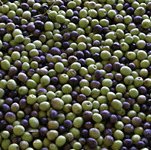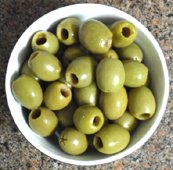Olives Nutrition facts
Olives are oval-shaped fruits obtained from the Olea europaea tree; a naturalized, medium-size tree of Mediterranean origin. The fresh fruit and oil extracted from them have been part of staple food sources for the natives around the Mediterranean Sea for centuries.
Ancient Greeks believed that growing olives would bring peace and prosperity since the entire population relied upon it to secure most of life's essentialities.
Botanically, the fruits belong to the family of Oleaceae, in the genus: Olea.
 |

|
| Olive tree. Courtesy: A.Poulos | Olives (Olea europaea). |
Olive is a slow-growing, evergreen tree with a gnarled trunk dividing into gray, fissured branches and foliage of gray-green, fleshy, narrow leaves. It may reach up to 50 feet in height in its natural habitat and may last for more than 500 years.
It grows well under frost-free, dry, and well-drained soils. Normally, it starts producing fruits at the age of 3-4 years. However, some cultivars may take a much longer time before their first harvest. The tree blooms in the spring, which subsequently develops into a small round to oval green berries by summer.
Olive is a drupe or "stone fruit" with a central single seed (pit), surrounded by edible pulp. Their size and shape greatly vary depending on the cultivar type. On average, a fruit weighs about 3-5 g. Raw fruits are green and turn yellow to dark as they ripen further.
Olives are normally picked at different stages depending upon whether they are destined to be used as table fruits or pressed into oil.
Health Benefits of Olives
Traditionally, olives have been viewed as a very healthy food. Besides providing energy, they compose significant amounts of plant-derived antioxidants, minerals, phytosterols, and vitamins.
Olives are a modest source of calories; 100 g of fruits carry just 115 calories. Their calorie content primarily comes from fats. Nonetheless, the fruit composes healthy fat in the form of monounsaturated fatty acids (MUFA) like oleic acid (18:1) and palmitoleic acid (16:1) that help lower LDL (bad cholesterol) and increase HDL (good cholesterol) in the blood.
Research studies suggest that the Mediterranean diet which is rich in monounsaturated fatty acids helps to prevent coronary artery disease and strokes by favoring a healthy blood lipid profile.
Olive fruit contains tyrosol phenolic compounds such as oleuropein and oleocanthal. These compounds are responsible for their bitter and pungent taste. Oleocanthal, oleuropein, and its derivative hydroxytyrosol are nature’s most powerful antioxidants. Together with vitamin E and carotenoids, they play a vital role in fighting against cancer, inflammation, coronary artery disease, degenerative nerve diseases, and diabetes.
Studies suggest that oleocanthal has ibuprofen (NSAID) like anti-inflammatory activities. The Mediterranean diet that uses olive and its oil may be responsible in part for the lower incidences of coronary artery disease.
Olive contains a good amount of vitamin E. 100 g of cured and canned fruits provide 1.65 mg (11% of RDA) of α-tocopherol. Vitamin E is a powerful lipid-soluble antioxidant, required for maintaining the integrity of the cell membrane of mucosa and skin by protecting it from harmful oxygen-free radicals.
Also, they contain healthy amounts of minerals like calcium, copper, iron, manganese, and zinc. Further, they are small sources of B-complex vitamins such as niacin, choline, and pantothenic acid.
Oil expressed from these fruits is recognized as one of the healthiest edible oils since it contains less saturated fat and composes linoleic (omega-6) and linolenic acid (omega-3) essential fatty acids at the recommended 8:1 ratio.
| Principle | Nutrient Value | Percent of RDA |
|---|---|---|
| Energy | 115 Kcal | 5.75% |
| Carbohydrates | 6.26 g | 5% |
| Protein | 0.84 g | 1.5% |
| Total Fat | 10.68 g | 50% |
| Cholesterol | 0 mg | 0% |
| Dietary Fiber | 3.2 g | 8% |
| Vitamins | ||
| Folates | 0 µg | 0% |
| Niacin | 0.037 mg | <1% |
| Pantothenic acid | 0.015 mg | <1% |
| Pyridoxine | 0.009 mg | 0% |
| Riboflavin | 0 mg | 0% |
| Thiamin | 0.003 mg | 0% |
| Vitamin A | 403 IU | 13.5% |
| Vitamin C | 0.9 | 1% |
| Vitamin E | 1.65 mg | 11% |
| Vitamin K | 1.4 µg | 1% |
| Electrolytes | ||
| Sodium | 735 mg | 49% |
| Potassium | 8 mg | 17% |
| Minerals | ||
| Calcium | 88 mg | 9% |
| Copper | 0.251 mg | 28% |
| Iron | 3.30 mg | 41% |
| Magnesium | 4 mg | 1% |
| Manganese | 0.020 mg | 1% |
| Phosphorus | 3 mg | <1% |
| Selenium | 0.9 µg | 1.5% |
| Zinc | 0.22 mg | 2% |
| Phyto-nutrients | ||
| Carotene-ß | 237 µg | -- |
| Crypto-xanthin-ß | 9 µg | -- |
| Lutein-zeaxanthin | 510 µg | -- |
| Phytosterols | 221mg | -- |
| Lipids (fatty acids) | ||
| Total saturated | 1.415 g | -- |
| Total Monounsaturated | 7.888 g | -- |
| Total Poly-unsaturated | 0.911 g | -- |
Selection and storage

|
| Cured green olives. |
Raw Olives cannot be eaten as they are because of the bitter principle of oleuropein. Some enthusiast olive fans may want to cure them on their own. If you are placed at close quarters to any olive farms that sell raw fruits, try to buy fresh olives for home-curing. Otherwise, almost all the types of olives available in the markets are already treated and cured.
In the groceries, customers are equally spoiled of choices; pitted, oil-cured, stuffed, sliced, etc. Home-cured olives should be placed inside a plastic or glass container immersed in a light brine or olive oil. For extended storage, place them under strong brine.
Once at home, packed/canned olives may be placed in a dark cool place until the “use by” date from the manufacturer. However, once opened, the fruits should be kept in the refrigerator, preferably transferred onto a glass or plastic bowl and immersed in the brine. Use them within 1-2 months of purchase.
Preparation and serving methods
Cured olives have been an integral part of the Mediterranean diet since ancient times, especially in Greece, Spain, and Italian households.
Cured and ready-to-eat olives are readily available in the stores. All that you need to do once you open the jar is to give them a wash in clean water to bring down their sodium content. Some people prefer to cure olives at home by employing traditional methods and avoid commercial "lye-cured" (sodium hydroxide) ones for many reasons.
Cured black and green olives are equally popular as finger food in Europe. They are also one of the sought-after ingredients in recipes all over the world. Some of the well-known black (ripe) types include Manzanillo from Spain and Kalamata from Greece, and among the green types are Hojiblanca (Spain) and Lucques (France).
Here are some serving tips
Traditionally, olives are eaten as a side dish or snack.
They chiefly served as appetizers or starters.
Pitted and sliced olives add great flavor to salads, pasta, and pizza toppings.
They also give a special salty flavor to dips, sauces, tapenades, etc.
Safety profile
Olives are safe food to eat; however, some people may manifest some allergic symptoms to lye-brine (caustic soda). Additionally, lye or salt-cured olives contain a higher concentration of sodium than the recommended intake. Shift the fruits into a bowl and wash them in clean water a few times until all the lye/salt content is removed. (Medical disclaimer).
Read further on:
≺≺ What is the Mediterranean Diet? A Complete Guide to Benefits & Foods.
≺≺ olive oil nutrition facts and health beneifts.
≻≻-Back to Fruits from Olives nutrition. Visit here for an impressive list of all varieties of fruits with complete illustrations of their nutrition facts and health benefits.
≻≻-Back to Home page.
Further reading and Resources:
USDA National Nutrient Database. (opens new window).
International Olive Council-International Olive council.